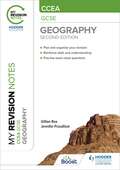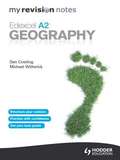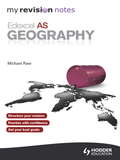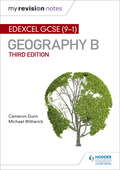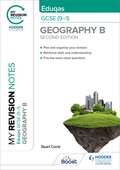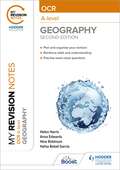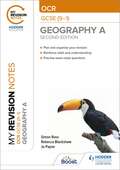- Table View
- List View
My Revision Notes: AQA GCSE (9–1) Geography Second Edition
by Simon Ross Rebecca BlackshawSet your students on track to achieve the best grade possible with My Revision Notes. Our updated approach to revision will help students learn, practise and apply their skills and understanding. Coverage of key content is combined with practical study tips and effective revision strategies to create a guide that can be relied on to build both knowledge and confidence.My Revision Notes: AQA GCSE (9-1) Geography will help students:- Develop subject knowledge by making links between topics for more in-depth exam answers- Plan and manage revision with our topic-by-topic planner and exam breakdown introduction- Practise and apply skills and knowledge with Exam-style questions and frequent check yourunderstanding questions, and answer guidance online- Build quick recall with bullet- pointed summaries at the end of each chapter- Understand key terms for the exam with user-friendly definitions and a glossary- Avoid common mistakes and enhance exam answers with Examiner tips- Improve subject-specific skills with an Exam skills checkbox at the end of each chapter
My Revision Notes: AQA GCSE (9–1) Geography Second Edition
by Simon Ross Rebecca BlackshawSet your students on track to achieve the best grade possible with My Revision Notes. Our updated approach to revision will help students learn, practise and apply their skills and understanding. Coverage of key content is combined with practical study tips and effective revision strategies to create a guide that can be relied on to build both knowledge and confidence.My Revision Notes: AQA GCSE (9-1) Geography will help students:- Develop subject knowledge by making links between topics for more in-depth exam answers- Plan and manage revision with our topic-by-topic planner and exam breakdown introduction- Practise and apply skills and knowledge with Exam-style questions and frequent check yourunderstanding questions, and answer guidance online- Build quick recall with bullet- pointed summaries at the end of each chapter- Understand key terms for the exam with user-friendly definitions and a glossary- Avoid common mistakes and enhance exam answers with Examiner tips- Improve subject-specific skills with an Exam skills checkbox at the end of each chapter
My Revision Notes: CCEA GCSE Geography (Geography For Ccea Ser.)
by Jennifer Proudfoot Gillian ReaTarget success in CCEA GCSE Geography with this proven formula for effective, structured revision; key content coverage is combined with exam-style tasks and practical tips to create a revision guide that students can rely on to review, strengthen and test their knowledge.With My Revision Notes every student can:- Plan and manage a successful revision programme using the topic-by-topic planner- Enjoy an active approach to revision with clear topic coverage and related 'Now Test Yourself' tasks and practical revision activities- Improve exam technique through exam tips and formal exam-style questions- Monitor their knowledge and progress using the answers provided for each 'Now Test Yourself' activity and exam-style question- Develop geographical understanding and enhance exam responses with case study material
My Revision Notes: CCEA GCSE Geography Second Edition
by Jennifer Proudfoot Gillian ReaSet your students on track to achieve the best grade possible with My Revision Notes. Our updated approach to revision will help students learn, practise and apply their skills and understanding. Coverage of key content is combined with practical study tips and effective revision strategies to create a guide that can be relied on to build both knowledge and confidence. My Revision Notes: CCEA GCSE (9-1) Geography will help students: - Plan and manage revision with our topic-by-topic planner and exam breakdown introduction - Practise and apply skills and knowledge with Exam-style questions and frequent check your understanding questions, and answer guidance online - Build quick recall with bullet- pointed summaries at the end of each chapter - Understand key terms for the exam with user-friendly definitions and a glossary - Avoid common mistakes and enhance exam answers with Examiner tips - Improve subject-specific skills with an Exam skills checkbox at the end of each chapter
My Revision Notes: CCEA GCSE Geography Second Edition
by Jennifer Proudfoot Gillian ReaSet your students on track to achieve the best grade possible with My Revision Notes. Our updated approach to revision will help students learn, practise and apply their skills and understanding. Coverage of key content is combined with practical study tips and effective revision strategies to create a guide that can be relied on to build both knowledge and confidence. My Revision Notes: CCEA GCSE (9-1) Geography will help students: - Plan and manage revision with our topic-by-topic planner and exam breakdown introduction - Practise and apply skills and knowledge with Exam-style questions and frequent check your understanding questions, and answer guidance online - Build quick recall with bullet- pointed summaries at the end of each chapter - Understand key terms for the exam with user-friendly definitions and a glossary - Avoid common mistakes and enhance exam answers with Examiner tips - Improve subject-specific skills with an Exam skills checkbox at the end of each chapter
My Revision Notes: Edexcel A2 Geography
by Michael Witherick Dan CowlingUnlock your full potential with these revision guides which focus on the key content and skills you need to know.With My Revision Notes for Edexecl A2 Geography you can: Take control of your revision: plan and focus on the areas you need to revise with content summaries and commentary from authors Dan Cowling and Michael WitherickShow you fully understand key topics by using specific examples to add depth to your knowledge of geographical issues and processesApply geographical terms accurately with the help of definitions and key words on all topicsImprove your skills to tackle specific exam questions with self-testing and exam-style questions and answersGet exam-ready with last-minute quick quizzes at www.hodderplus.co.uk/myrevisionnotes
My Revision Notes: Edexcel AS Geography
by Michael RawUnlock your full potential with these revision guides which focus on the key content and skills you need to know.With My Revision Notes for Edexcel AS Geography you can:Take control of your revision: plan and focus on the areas you need to revise with content summaries and commentary from author Michael RawShow you fully understand key topics by using specific examples to add depth to your knowledge of geographical issues and processesApply geographical terms accurately with the help of definitions and key words on all topicsImprove your skills to tackle specific exam questions with self-testing and exam-style questions and answersGet exam-ready with last-minute quick quizzes at www.hodderplus.co.uk/myrevisionnotes
My Revision Notes: Edexcel AS/A-level Geography
by Michael Witherick Dan CowlingTarget success in Edexcel AS/A-level Geography with this proven formula for effective, structured revision; key content coverage is combined with exam-style tasks and practical tips to create a revision guide that students can rely on to review, strengthen and test their knowledge.With My Revision Notes every student can:- Plan and manage a successful revision programme using the topic-by-topic planner- Consolidate subject knowledge by working through clear and focused content coverage- Test understanding and identify areas for improvement with regular 'Now Test Yourself' tasks and answers- Enhance exam responses using relevant case studies for each topic- Improve exam technique through practice questions, expert tips and examples of typical mistakes to avoid
My Revision Notes: Edexcel GCSE (91) Geography B Third Edition
by Cameron Dunn Michael WitherickExam Board: EdexcelLevel: GCSESubject: GeographyFirst Teaching: September 2016First Exam: Summer 2018Endorsed for EdexcelTarget success in Edexcel GCSE (9-1) Geography B with this proven formula for effective, structured revision; key content coverage is combined with exam-style tasks and practical tips to create a revision guide that students can rely on to review, strengthen and test their knowledge.With My Revision Notes every student can:- Plan and manage a successful revision programme using the topic-by-topic planner- Enjoy an active approach to revision with clear topic coverage and related 'Now Test Yourself' tasks and practical revision activities- Improve exam technique through exam tips and formal exam-style questions- Monitor their knowledge and progress using the answers provided for each 'Now Test Yourself' activity and exam-style question- Develop geographical understanding and enhance exam responses with case study material and located place examples
My Revision Notes: Edexcel GCSE (91) Geography A Second Edition
by Steph WarrenTarget success in Edexcel GCSE (9-1) Geography A with this proven formula for effective, structured revision; key content coverage is combined with exam-style tasks and practical tips to create a revision guide that students can rely on to review, strengthen and test their knowledge.With My Revision Notes every student can:- Plan and manage a successful revision programme using the topic-by-topic planner- Enjoy an active approach to revision with clear topic coverage and related 'Now Test Yourself' tasks- Improve exam technique through exam tips and formal exam-style questions- Monitor their knowledge and progress using the answers provided for each 'Now Test Yourself' activity and exam-style question- Develop geographical understanding and enhance exam responses with case study material and located place examples
My Revision Notes: Edexcel GCSE (9–1) Geography A Second Edition
by Steph WarrenExam board: EdexcelLevel: GCSESubject: Geography First teaching: September 2016First exams: Summer 2018Target success in Edexcel GCSE (9-1) Geography A with this proven formula for effective, structured revision; key content coverage is combined with exam-style tasks and practical tips to create a revision guide that students can rely on to review, strengthen and test their knowledge.With My Revision Notes every student can:- Plan and manage a successful revision programme using the topic-by-topic planner- Enjoy an active approach to revision with clear topic coverage and related 'Now Test Yourself' tasks- Improve exam technique through exam tips and formal exam-style questions- Monitor their knowledge and progress using the answers provided for each 'Now Test Yourself' activity and exam-style question- Develop geographical understanding and enhance exam responses with case study material and located place examples
My Revision Notes: Edexcel GCSE (Edexcel GCSE Geography B)
by Cameron Dunn Michael WitherickExam Board: EdexcelLevel: GCSESubject: GeographyFirst Teaching: September 2016First Exam: Summer 2018Endorsed for EdexcelTarget success in Edexcel GCSE (9-1) Geography B with this proven formula for effective, structured revision; key content coverage is combined with exam-style tasks and practical tips to create a revision guide that students can rely on to review, strengthen and test their knowledge.With My Revision Notes every student can:- Plan and manage a successful revision programme using the topic-by-topic planner- Enjoy an active approach to revision with clear topic coverage and related 'Now Test Yourself' tasks and practical revision activities- Improve exam technique through exam tips and formal exam-style questions- Monitor their knowledge and progress using the answers provided for each 'Now Test Yourself' activity and exam-style question- Develop geographical understanding and enhance exam responses with case study material and located place examples
My Revision Notes: Eduqas GCSE (9–1) Geography B Second Edition
by Stuart CurrieSet your students on track to achieve the best grade possible with My Revision Notes. Our updated approach to revision will help students learn, practise and apply their skills and understanding. Coverage of key content is combined with practical study tips and effective revision strategies to create a guide that can be relied on to build both knowledge and confidence. My Revision Notes: Eduqas GCSE (9-1) Geography B will help students: - Develop subject knowledge by making links between topics for more in-depth exam answers - Plan and manage revision with our topic-by-topic planner and exam breakdown introduction - Practise and apply skills and knowledge with Exam-style questions and frequent check your understanding questions, and answer guidance online - Build quick recall with bullet- pointed summaries at the end of each chapter - Understand key terms for the exam with user-friendly definitions and a glossary - Avoid common mistakes and enhance exam answers with Examiner tips - Improve subject-specific skills with an Exam skills checkbox at the end of each chapter
My Revision Notes: Eduqas GCSE (9–1) Geography B Second Edition
by Stuart CurrieSet your students on track to achieve the best grade possible with My Revision Notes. Our updated approach to revision will help students learn, practise and apply their skills and understanding. Coverage of key content is combined with practical study tips and effective revision strategies to create a guide that can be relied on to build both knowledge and confidence. My Revision Notes: Eduqas GCSE (9-1) Geography B will help students: - Develop subject knowledge by making links between topics for more in-depth exam answers - Plan and manage revision with our topic-by-topic planner and exam breakdown introduction - Practise and apply skills and knowledge with Exam-style questions and frequent check your understanding questions, and answer guidance online - Build quick recall with bullet- pointed summaries at the end of each chapter - Understand key terms for the exam with user-friendly definitions and a glossary - Avoid common mistakes and enhance exam answers with Examiner tips - Improve subject-specific skills with an Exam skills checkbox at the end of each chapter
My Revision Notes: OCR A-Level Geography: Second Edition
by Helen Harris Anna Edwards Hina Robinson Hafsa Bobat GarciaSet students on track to achieve the best grade possible with My Revision Notes.Our clear and concise approach to revision will help students learn, practise and apply their skills and understanding. Coverage of key content is combined with practical study tips and effective revision strategies to create a guide that can be relied on to build both knowledge and confidence.My Revision Notes: OCR A Level Geography (Second Edition) will help students:- Consolidate knowledge with clear, concise and relevant content coverage, based on what examiners are looking for- Extend understanding with our regular 'Now Test Yourself', tasks and answers- Improve technique through our increased exam support, including exam-style practice questions, expert tips and examples of typical mistakes to avoid- Identify key connections between topics and subjects with our 'Making Links' focus and further ideas for follow-up and revision activities- Plan and manage a successful revision programme with our topic-by-topic planner, new skills checklist and exam breakdown features, user-friendly definitions and glossary
My Revision Notes: OCR A-Level Geography: Second Edition
by Helen Harris Anna Edwards Hina Robinson Hafsa Bobat GarciaSet students on track to achieve the best grade possible with My Revision Notes.Our clear and concise approach to revision will help students learn, practise and apply their skills and understanding. Coverage of key content is combined with practical study tips and effective revision strategies to create a guide that can be relied on to build both knowledge and confidence.My Revision Notes: OCR A Level Geography (Second Edition) will help students:- Consolidate knowledge with clear, concise and relevant content coverage, based on what examiners are looking for- Extend understanding with our regular 'Now Test Yourself', tasks and answers- Improve technique through our increased exam support, including exam-style practice questions, expert tips and examples of typical mistakes to avoid- Identify key connections between topics and subjects with our 'Making Links' focus and further ideas for follow-up and revision activities- Plan and manage a successful revision programme with our topic-by-topic planner, new skills checklist and exam breakdown features, user-friendly definitions and glossary
My Revision Notes: OCR AS/A-level Geography
by Helen HarrisTarget success in OCR AS/A-level Geography with this proven formula for effective, structured revision; key content coverage is combined with exam-style tasks and practical tips to create a revision guide that students can rely on to review, strengthen and test their knowledge.With My Revision Notes every student can:- Plan and manage a successful revision programme using the topic-by-topic planner- Consolidate subject knowledge by working through clear and focused content coverage- Test understanding and identify areas for improvement with regular 'Now Test Yourself' tasks and answers- Enhance exam responses using relevant case studies for each topic- Improve exam technique through practice questions, expert tips and examples of typical mistakes to avoid
My Revision Notes: OCR AS/A-level Geography
by Helen HarrisExam board: OCRLevel: A-levelSubject: Geography First teaching: September 2016First exams: Summer 2017Target success in OCR AS/A-level Geography with this proven formula for effective, structured revision; key content coverage is combined with exam-style tasks and practical tips to create a revision guide that students can rely on to review, strengthen and test their knowledge.With My Revision Notes every student can:- Plan and manage a successful revision programme using the topic-by-topic planner- Consolidate subject knowledge by working through clear and focused content coverage- Test understanding and identify areas for improvement with regular 'Now Test Yourself' tasks and answers- Enhance exam responses using relevant case studies for each topic- Improve exam technique through practice questions, expert tips and examples of typical mistakes to avoid
My Revision Notes: OCR GCSE (9-1) Geography A
by Simon Ross Jo Payne Rebecca BlackshawTarget success in OCR GCSE (9-1) Geography A with this proven formula for effective, structured revision; key content coverage is combined with exam-style tasks and practical tips to create a revision guide that students can rely on to review, strengthen and test their knowledge.With My Revision Notes every student can:- Plan and manage a successful revision programme using the topic-by-topic planner- Enjoy an active approach to revision with clear topic coverage and related 'Now Test Yourself' tasks and practical revision activities- Improve exam technique through exam tips and formal exam-style questions- Monitor their knowledge and progress using the answers provided for each 'Now Test Yourself' activity and exam-style question- Develop geographical understanding and enhance exam responses with case study material
My Revision Notes: OCR GCSE (9-1) Geography A Second Edition
by Simon Ross Jo Payne Rebecca BlackshawSet your students on track to achieve the best grade possible with My Revision Notes. Our updated approach to revision will help students learn, practise and apply their skills and understanding. Coverage of key content is combined with practical study tips and effective revision strategies to create a guide that can be relied on to build both knowledge and confidence.My Revision Notes: OCR GCSE (9-1) Geography A will help students: - Develop subject knowledge by making links between topics for more in-depth exam answers - Plan and manage revision with our topic-by-topic planner and exam breakdown introduction - Practise and apply skills and knowledge with Exam-style questions and frequent check your understanding questions, and answer guidance online - Build quick recall with bullet- pointed summaries at the end of each chapter - Understand key terms for the exam with user-friendly definitions and a glossary - Avoid common mistakes and enhance exam answers with Examiner tips - Improve subject-specific skills with an Exam skills checkbox at the end of each chapter
My Revision Notes: OCR GCSE (9-1) Geography A Second Edition
by Simon Ross Jo Payne Rebecca BlackshawSet your students on track to achieve the best grade possible with My Revision Notes. Our updated approach to revision will help students learn, practise and apply their skills and understanding. Coverage of key content is combined with practical study tips and effective revision strategies to create a guide that can be relied on to build both knowledge and confidence.My Revision Notes: OCR GCSE (9-1) Geography A will help students: - Develop subject knowledge by making links between topics for more in-depth exam answers - Plan and manage revision with our topic-by-topic planner and exam breakdown introduction - Practise and apply skills and knowledge with Exam-style questions and frequent check your understanding questions, and answer guidance online - Build quick recall with bullet- pointed summaries at the end of each chapter - Understand key terms for the exam with user-friendly definitions and a glossary - Avoid common mistakes and enhance exam answers with Examiner tips - Improve subject-specific skills with an Exam skills checkbox at the end of each chapter
My Revision Notes: OCR GCSE (9-1) Geography B Second Edition
by Simon Ross Jo Payne Rebecca BlackshawTarget exam success with My Revision Notes. Our updated approach to revision will help students learn, practise and apply their skills and understanding. Coverage of key content is combined with practical study tips and effective revision strategies to create a guide that can be relied on to build both knowledge and confidence. My Revision Notes: OCR GCSE (9-1) Geography B will help students: - Develop subject knowledge by making links between topics for more in-depth exam answers - Plan and manage revision with our topic-by-topic planner and exam breakdown introduction - Practise and apply skills and knowledge with Exam-style questions and frequent check your understanding questions, and answer guidance online - Build quick recall with bullet- pointed summaries at the end of each chapter - Understand key terms for the exam with user-friendly definitions and a glossary - Avoid common mistakes and enhance exam answers with Examiner tips - Improve subject-specific skills with an Exam skills checkbox at the end of each chapter
My Revision Notes: OCR GCSE (9-1) Geography B Second Edition
by Simon Ross Jo Payne Rebecca BlackshawTarget exam success with My Revision Notes. Our updated approach to revision will help students learn, practise and apply their skills and understanding. Coverage of key content is combined with practical study tips and effective revision strategies to create a guide that can be relied on to build both knowledge and confidence. My Revision Notes: OCR GCSE (9-1) Geography B will help students: - Develop subject knowledge by making links between topics for more in-depth exam answers - Plan and manage revision with our topic-by-topic planner and exam breakdown introduction - Practise and apply skills and knowledge with Exam-style questions and frequent check your understanding questions, and answer guidance online - Build quick recall with bullet- pointed summaries at the end of each chapter - Understand key terms for the exam with user-friendly definitions and a glossary - Avoid common mistakes and enhance exam answers with Examiner tips - Improve subject-specific skills with an Exam skills checkbox at the end of each chapter
My Revision Notes: OCR GCSE (91) Geography B
by Simon Ross Jo Payne Rebecca BlackshawTarget success in OCR GCSE (9-1) Geography B with this proven formula for effective, structured revision; key content coverage is combined with exam-style tasks and practical tips to create a revision guide that students can rely on to review, strengthen and test their knowledge.With My Revision Notes every student can:- Plan and manage a successful revision programme using the topic-by-topic planner- Enjoy an active approach to revision with clear topic coverage and related 'Now Test Yourself' tasks and practical revision activities- Improve exam technique through exam tips and formal exam-style questions- Monitor their knowledge and progress using the answers provided for each 'Now Test Yourself' activity and exam-style question- Develop geographical understanding and enhance exam responses with case study material
My Revision Notes: Pearson Edexcel A level Geography: Third Edition
by Michael Witherick Dan Cowling Michael Chiles Philly SimmonsTarget exam success with My Revision Notes. Our updated approach to revision will help students learn, practise and apply their skills and understanding. Coverage of key content is combined with practical study tips and effective revision strategies to create a guide that can be relied on to build both knowledge and confidence.My Revision Notes: Pearson Edexcel A-level Geography will help students:- Develop subject knowledge by making links between topics for more in-depth exam answers- Plan and manage revision with our topic-by-topic planner and exam breakdown introduction- Practise and apply skills and knowledge with Exam-style questions and frequent check your understanding questions, and answer guidance online- Build quick recall with bullet- pointed summaries at the end of each chapter- Understand key terms for the exam with user-friendly definitions and a glossary- Avoid common mistakes and enhance exam answers with Examiner tips- Improve subject-specific skills with an Exam skills checkbox at the end of each chapter


